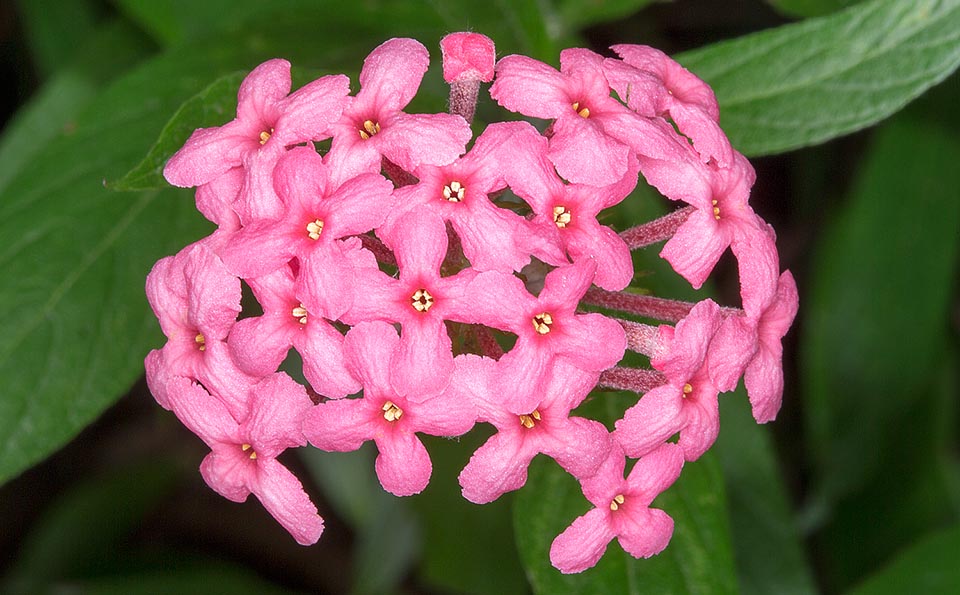Family : Rubiaceae

Text © Pietro Puccio

English translation by Mario Beltramini
The species is native to Mexico (Aguascalientes, Baja California, Baja California Sur, Campeche, Chiapas, Chihuahua, Coahuila, Colima, Districto Federal, Durango, Guanajuato, Guerrero, Hidalgo, Jalisco, Mexico, Michoacán, Morelos, Nayarit, Nuevo León, Oaxaca, Puebla, Querétaro, Quintana Roo, San Luis Potosí, Sinaloa, Sonora, Tabasco, Tamaulipas, Tlaxcala, Veracruz, Yucatán and Zacatecas) where it grows in the thickets at low altitudes.
The name of the genus is the combination of the Greek substantives “ἀράχνη” (arachne) = spider and “θρίξ” (thryx) = hair, with reference to the arachnoidal pubescence; the specific name is the combination of the Greek adjective “λευκός” (leucós) = white and “φύλλον” (phyllon) = leaf, with reference to the whitish tomentum present in the lower page of the leaf.
Common names: bush pentas, Panama rose (English); dama de noche, hierba de la muchachita, huele de la noche, lipa-caudaz (Mexico).
The Arachnothryx leucophylla (Kunth) Planch. (1849) is a evergreen woody shrub, 1-2,5 m tall, with young pubescent branches, triangular stipules with pointed apex, 0,6-0,8 cm long, and leaves, on an about 3 mm long petiole, opposite, simple, lanceolate with pointed apex and entire margins, 3-8 cm long and 0,5-2,5 cm broad, of dark green colour and slightly pubescent above, covered by a whitish tomentum below. Terminal inflorescences, on an about 6 cm long peduncle covered by whitish tomentum, compact, roundish, of about 5 cm of diameter, bearing numerous hermaphroditic flowers with calyx with 4 linear lanceolate lobes with pointed apex, unequal, 0,4-0,8 cm long. Hypocrateriform corolla (with lobes spread perpendicular to a long thin tube) of intense pink to red colour, cylindrical tube, about 1,8-2,2 cm long, covered by whitish tomentum, quadriparted margin, of about 1,3 cm of diameter, with obovate and wavy on the margins lobes, 0,5 cm long, 4 sessile anthers and filiform style, 1,2 cm long, with bifid stigma. The flowers, rich of nectar that attracts butterflies and hummingbirds, emit a slight scent during the day that considerably intensifies in the night hours. The fruits are whitish globose capsules, dehiscent in two valves, containing several seeds.

Native to Mexico, Arachnothryx leucophylla is a 1-2,5 m evergreen shrub. Elegant inflorescences of about 5 cm of diameter with several tubular hermaphroditic small perfumed flowers with rounded perpendicular lobes. Remarkable ornamental and landscape effect for parks and gardens in the tropical and subtropical climate zones © Giuseppe Mazza
Of remarkable ornamental and landscape effect for parks and gardens of the tropical and subtropical climate zones where it blooms abundantly in winter and spring and sporadically in the rest of the year, one can try its cultivation in the milder temperate-warm ones where it can stand values of temperature exceptional and short lasting around the 0 °C, but with damage to the foliage. It requires full sun for a best blooming, or at the most a slight shade, and fertile soils, draining, preferably acidic or neutral, maintained almost constantly humid, even if well rooted can stand drought periods; it has a slight tolerance to the saltness and consequently can be utilized in sites close to the sea. The waterings must be regular, in particular in the dry periods with high temperatures. Possible prunings must be done in late spring-early summer for a more compact posture and for stimulating the new vegetation and consequent blooming. It well adapts to the cultivation in pot for the decoration of patios and terraces or for being sheltered in protected ambient, at the maximum possible luminosity, where the climate does not allow the continuous permanence in open air, utilizing a fertile and draining loam with regular waterings in summer, more spaced in winter, but without ever allowing it to dry up completely, and fertilizations preferably with a slow release product with low contents of notrogen and high of phosphorus for encouraging the flowering.
Synonyms: Rondeletia leucophylla Kunth (1820); Hedyotis leucophylla (Kunth) Spreng. (1824); Rondeletia elongata Bartl. ex DC. (1830); Bouvardia discolor Hook. & Arn. (1840); Arachnothryx elongata (Bartl. ex DC.) Planch. (1849); Rondeletia dubia Hemsl. (1879); Rondeletia leucophylla var. calycosa Greenm. (1903); Rondeletia leptodictya B.L.Rob. (1910); Rondeletia yucatanensis Lundell (1976); Arachnothryx leptodictya (B.L.Rob.) Borhidi (1982); Arachnothryx yucatanensis (Lundell) Borhidi (1989).
→ To appreciate the biodiversity within the RUBIACEAE family please click here.
